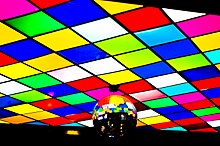Disco (music)
| Disco | |
|---|---|

The ceiling of an Arlington, Texas discothèque
|
|
| Stylistic origins | |
| Cultural origins | Late-1960s – early 1970s, East Coast of the United States |
| Typical instruments | |
| Derivative forms | |
| Subgenres | |
| Fusion genres | |
| Regional scenes | |
| Other topics | |
Disco is a musical style originating in the early 1970s that remained urban and largely underground until the middle of the decade when it began to emerge from America's urban nightlife scene, where it had been curtailed to house parties and makeshift discotheques, and began making regular appearances mainstream, gaining popularity and increasing airplay on radio. It achieved popularity during the mid-1970s to the early 1980s. Its initial audiences in the U.S. were club-goers from the gay, African American, Italian American,Latino, and psychedelic communities in Philadelphia, San Francisco, and New York City during the late 1960s and early 1970s. Disco can be seen as a reaction against both the domination of rock music and the stigmatization of dance music by the counterculture during this period. Disco was popular with both men and women from many different backgrounds, with dances including the Bump and the Hustle.
The disco sound often has several components, a "four-on-the-floor" beat, an eighth note (quaver) or 16th note (semi-quaver) hi-hat pattern with an open hi-hat on the off-beat, and a prominent, syncopated electric bass line. In most disco tracks, string sections, horns, electric piano, and electric rhythm guitars create a lush background sound. Orchestral instruments such as the flute are often used for solo melodies, and lead guitar is less frequently used in disco than in rock. Many disco songs use electronic synthesizers, particularly in the late 1970s.
...
Wikipedia
